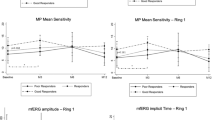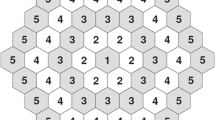Abstract
Purpose
To evaluate the influence of ranibizumab on the multifocal electroretinogram (Mf-ERG), full-field electroretinogram (Ff-ERG) and optical coherence tomography (OCT) in diabetic eyes (n = 20) with macular oedema.
Methods
In 20 eyes (20 diabetic subjects) with no or background diabetic retinopathy and macular oedema (age 65.7 ± 9.8 years, duration 16.5 ± 10.0 years), the change in ETDRS letters, Mf-ERG, Ff-ERG and OCT was analysed, at baseline, 4 weeks after the first injection, (just before the second injection), and 4 weeks after the last injection with ranibizumab.
Results
From baseline, mean BCVA improved from 64.0 ± 10.0 ETDRS letters to 75.0 ± 7.3 ETDRS letters (p = 0.005) 1 month after the last injection. Mean OCT thickness reduced after the first injection from 418 ± 117 to 311 ± 126 µm; (p = 0.001) and to 302 ± 74 µm after the third injection. Mf-ERG demonstrated in the innermost three rings a shorter implicit time after the first injection with p values of 0.002, 0.005 and 0.017, respectively. After the third injection, implicit time was prolonged to almost the original levels. Cone implicit time with 30-Hz flicker improved significantly between baseline (35.5 ± 3.6 ms) and final follow-up (34.6 ± 3.1 ms) (p = 0.04).
Discussion
Though the central retinal thickness was reduced after three injections of ranibizumab and the subjects gained a mean of 11 ETDRS letters, there was no significant change in amplitude or implicit time in Mf-ERG. The shortened 30-Hz flicker implicit time might imply that ranibizumab has no negative impact on the entire peripheral cone function, but can improve it instead.





Similar content being viewed by others
References
Moss SE, Klein R, Klein BEK (1988) The incidence of vision loss in a diabetic population. Ophthalmology 95:1340–1348
Early Treatment Diabetic Retinopathy Study Research Group (1985) Photocoagulation for diabetic macular oedema: ETDRS report number 1. Arch Ophthalmol 103:1796–1806
Mitchell P, Bandello F, Schmidt-Erfurth U, Lang GE, Massin P, Schlingemann RO, Sutter F, Simader C, Burian G, Gerstner O, Weichselberger A, RESTORE study group (2011) The RESTORE study: Ranibizumab monotherapy or combined with laser versus laser monotherapy for diabetic macular edema. Ophthalmology 118(4):615–625
Massin P, Bandello F, Garweg JG, Hansen LL, Harding SP, Larsen M, Mitchell P, Sharp D, Wolf-Schnurrbusch UE, Gekkieva M, Weichselberger A, Wolf S (2010) Safety and efficacy of ranibizumab in diabetic macular edema (RESOLVE study): a 12-month, randomized, controlled, double- masked, multicenter phase II study. Diabetes Care 33(11):2399–2405
Grant MB, Afzal A, Spoerri P, Pan H, Shaw LC, Mames RN (2004) The role of growth factors in the pathogenesis of diabetic retinopathy. Expert Opin Investig Drugs 13(10):1275–1293
Ferrara N (2004) Vascular endothelial growth factor: basic science and clinical progress. Endocr Rev 25(4):581–611
Tolentino MJ, Miller JW, Gragoudas ES, Jakobiec FA, Flynn E, Chatzistefanou K, Ferrara N, Adamis AP (1996) Intravitreous injections of vascular endothelial growth factor produce retinal ischemia and microangiopathy in an adult primate. Ophthalmology 103(11):1820–1828
Ip MS, Domalpally A, Hopkins JJ, Wong P, Ehrlich JS (2012) Long-term effects of ranibizumab on diabetic retinopathy severity and progression. Arch Ophthalmol 130(9):1145–1152
Nunes S, Pereira I, Santos A, Bernardes R, Cunha-Vaz J (2010) Central retinal thickness measured with HD-OCT shows a weak correlation with visual acuity in eyes with CSME. Br J Ophthalmol 94(9):1201–1204
Holm K, Larsson J, Lövestam-Adrian M (2007) In diabetic retinopathy, foveal thickness of 300 µm seems to correlate with functionally significant loss of vision. Doc Ophthalmol 114(117–124):14
Alasil T, Keane PA, Updike JF, Dustin L, Ouyang Y, Walsh AC, Sadda SR (2010) Relationship between optical coherence tomography retinal parameters and visual acuity in diabetic macular edema. Ophthalmology 117(12):2379–2386
Marmor MF, Fulton AB, Holder GE, Miyake Y, Brigell M, Bach M (2009) Standard for clinical electroretinography (2008 update). Doc Ophthalmol 118:69–77
Hood DC, Bach M, Brigell M, Keating D, Kondo M, Lyons JS, Marmor MF, McCulloch DL, Palmowski-Wolfe AM (2012) ISCEV standard for clinical multifocal electroretinography (2011 edition). Doc Ophthalmol 124:1–13
Holm K, Ponjavic V, Lövestam-Adrian M (2010) Using multifocal electroretinography hard exudates affect macular function in eyes with diabetic retinopathy. Graefes Arch Clin Exp Ophthalmol 248:1241–1247
Kjeka O, Bredrup C, Krohn J (2007) Photopic 30 Hz flicker electroretinography predicts ocular neovascularization in central retinal vein occlusion. Acta Ophthalmol Scand 85(6):640–643
Larsson J, Bauer B, Andréasson S (2008) The 30-Hz flicker cone ERG for monitoring the early course of central retinal vein occlusion. Doc Ophthalmol 117(2):103–109
Gong Y, Wu X, Sun X, Zhang X, Zhu P (2008) Electroretinogram changes after scleral buckling surgery of retinal detachment. Doc Ophthalmol 117(2):103–109
Pedersen KB, Möller F, Sjölie AK, Andréasson S (2010) Electrophysiological assessment of retinal function during 6 months of bevacizumab treatment in neovascular age-related macular degeneration. Retina 30:1025–1033
Comyn O, Sivaprasad S, Peto T, Neveu MM, Holder GE, Xing W, Bunce CV, Patel PJ, Egan CA, Bainbridge JW, Hykin PG (2014) A randomized trial to assess functional and structural effects of ranibizumab versus laser in diabetic macular edema (the LUCIDATE study). Am J Ophthalmol 157:960–970
Schmidt-Erfurth U, Lang GE, Holz FG, Schlingemann RO, Lanzetta P, Massin P, Gerstner O, Bouazza AS, Shen H, Osborne A, Mitchell P; RESTORE Extension Study Group (2014) Three-year outcomes of individualized ranibizumab treatment in patients with diabetic macular edema: the RESTORE extension study. Ophthalmology 121(5):1045–1053
Lee JY, Folgar FA, Maguire MG, Ying GS, Toth CA, Martin DF, Jaffe GJ, CATT Research Group (2014) Outer retinal tubulation in the comparison of age-related macular degeneration treatments trials (CATT). Ophthalmology 121(12):2423–2431
Klemp K, Larsen M, Sander B, Vaag A, Brockhoff PB, Lund-Andersen H (2004) Effect of short-term hyperglycemia, on multifocal electroretinogram in diabetic patients without retinopathy. Invest Ophthalmol Vis Sci 45(10):3812–3819
Grunwald JE, Daniel E, Huang J, Ying GS, Maquire MG, Ca Toth, Jaffe GJ, Fine SL, Blodi B, Klein ML, Martin AA, Hagstrom SA, Martin DF, CATT Research Group (2014) Risk of geographic atrophy in the comparison of age-related macular degeneration treatments trials. Ophthalmology 121(1):150–161
Acknowledgments
This study was supported by Novartis Sweden AB.
Author information
Authors and Affiliations
Corresponding author
Rights and permissions
About this article
Cite this article
Holm, K., Schroeder, M. & Lövestam Adrian, M. Peripheral retinal function assessed with 30-Hz flicker seems to improve after treatment with Lucentis in patients with diabetic macular oedema. Doc Ophthalmol 131, 43–51 (2015). https://doi.org/10.1007/s10633-015-9495-9
Received:
Accepted:
Published:
Issue Date:
DOI: https://doi.org/10.1007/s10633-015-9495-9




